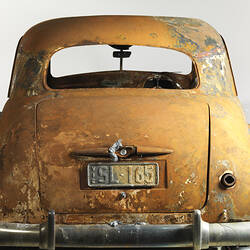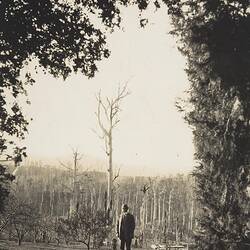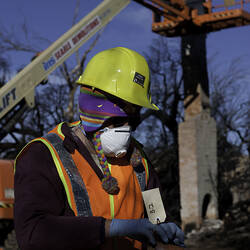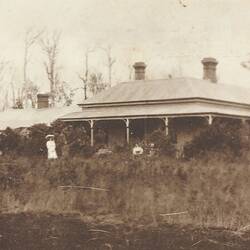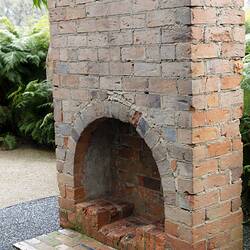The process of dismantling and reconstructing the Black Saturday Bushfire Chimney from Kinglake has uncovered a range of stories relating to its original construction and history of use:
Why is there no black on the bricks?
The bricks are not black because the fire was very hot and the flames were well above the height of the house. There are a few small soot marks at the base of the chimney - these are burn marks from a smaller fire that burnt after the house had been destroyed. Black marks on the front and right side of the lower part of the chimney came from the collapse of the large pine tree prior to the dismantling of the chimney. This tree was badly burnt by the bushfire and threatened to fall on the chimney. When it was felled prior to the dismantling, some of its burnt branches rested on the face of the chimney.
When was the chimney built?
The pressed mortar on the left and right faces indicate that the chimney was built within the existing framework of the house. This was typical of construction methods of the period with the framework constructed first, then the chimneys added.
Why does the colour of the chimney vary?
The lowest three courses of bricks have a distinctively apricot colour. This is the original colour of the bricks. These three courses were covered by the skirting boards and so have retained their original colour, the bricks above were more exposed to heat of the fire and are covered in white ash.
The white surface on the left, rear and front of the chimney indicates that the bushfire came from the left (east). The white colour is a remnant ash from the bushfire.
The right side has a variation of colour from white, to warm pinks, reds, purples and blues. This side was protected from the full force of the fire, and retained a mixture of the original colour of the bricks.
Why is the chimney not straight?
The metal flashing on the chimney represents the roof line. The lower flashing suggests that there was a lower roof line, or that the roof was altered at some time after the homestead was originally built. Looking from the rear of the chimney a series of single bricks indicate the internal form of the curve in the flue. This curve is designed to assist with the drawing power of the chimney. The kink in the upper section of the chimney could be a design feature to assist with the drawing of the chimney, or more likely an alteration in position to allow the top section to pass around a roof beam or to be aligned with the centreline of the roof.
How was the chimney built?
The mortar at the rear spills out from the bricks. This indicates that the bricks were laid from the front of the chimney, as it was not possible to scrape off the excess mortar.
The lower bricks are handmade. The folds and deep gashes show how each brick was pressed by hand into a wooden mould and left to be air dried in the sun prior to entering an open kiln in which they were fired.
Some bricks have thumb marks. This has a number of possible meanings, but could indicate a counting system, where every 100 bricks are marked by a thumb print.
A possum paw print can clearly be seen in a brick in the hearth. This would have been created while the bricks were drying in the sun, prior to going into the kiln. During the air drying process bricks were placed on their sides prior to firing.
The bricks above the roof line are of more uniform shape and have an imprint of the name 'Hoffman' in the upper face. Unlike the handmade bricks, these Hoffman bricks were machine pressed using a steam press, and kiln dried, then fired in a continuous 'Hoffman' kiln. It was common practice to limit the use of higher quality machine-made bricks to the prominent and exposed sections of chimneys. Hoffman Patent Brick & Tile Company was established in Albert Street, Brunswick, in 1870, being one of Melbourne's first mechanised brickworks.
The holes in the mortar at the front of the chimney indicate where the mantle piece was secured using wooden dowels.
References:
Gregory Hill, The Potteries of Brunswick, Shepparton Art Gallery (2000), pages 40-63.
http://mc2.vicnet.net.au/home/hoffmans/web/book_cd/index.html, viewed 25-11-2009.
http://www.auspottery.com/Hoffman_history.htm, viewed 25-11-2009.
http://vhd.heritage.vic.gov.au/places/heritage/59022, viewed 25-11-2009.
http://www.emelbourne.net.au/biogs/EM01213b.htm, viewed 25-11-2009.
Liza Dale-Hallett, 'Kinglake Chimney Finds New Life at Museum Victoria', in Mountain Monthly, (August 2009), page: 36.
More Information
-
Keywords
-
Localities
-
Authors
-
Article types

